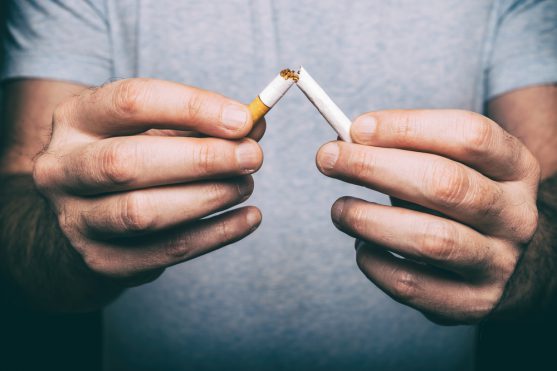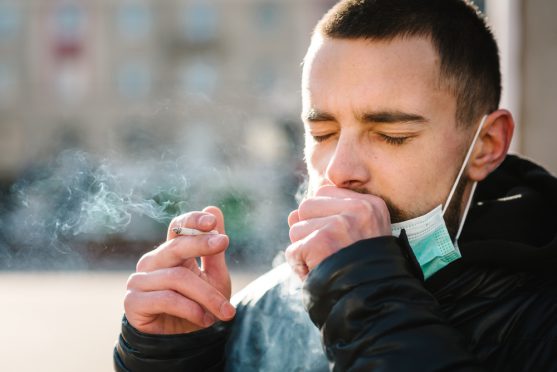Dr Rama Vaghmare is Consultant – Radiation Oncologist, Onco.com.
In this article, we look at the link between addiction mindset and the challenges faced to quit smoking.
Smoking and cancer: fact check
Tobacco smoke contains thousands of chemicals, including at least 70 known to cause cancer. These cancer-causing chemicals are known as carcinogens.
Some of the chemical carcinogens found in tobacco smoke include hydrogen cyanide, formaldehyde, nitrosamines etc. More than 50% of newly diagnosed lung cancer patients are former smokers. High levels of smoking leads to higher risk of cancer in both men and women.
The key worrying facts:
- Cigarette smokers die younger than non-smokers.
- Smoking shortens male smokers’ lives by about 12 years and female smokers’ lives by about 11 years.
- Smoking not only causes cancer, it can damage nearly every organ in the body, including the lungs, heart, blood vessels, reproductive organs, mouth, skin, eyes, and bones.
- About 80% of lung cancer deaths are thought to result from smoking.
- Lung cancer is the leading cause of cancer death in both men and women, and is one of the hardest cancers to treat. Not only does smoking increase the risk for lung cancer, it’s also a risk factor for cancers of the mouth, larynx, pharynx, esophagus, kidney, cervix, liver, bladder, pancreas, stomach and rectum.
How does smoking cause cancer?
Chemicals in cigarette smoke enter our bloodstream and can then affect the entire body, this is why smoking causes so many different types of cancer. The combination of harmful chemicals in tobacco have been found to damage the DNA.
If DNA is damaged, things can go wrong. The DNA adducts are central to the carcinogenic process that are induced by these harmful chemicals.
For example, a chemical, benzopyrene, causes damage specifically in a part of the DNA that normally protects our cells from cancer. The cocktail of chemicals in tobacco smoke is even more dangerous as a mix.
The public is well aware of the facts listed above and the risks associated with smoking. Then the question arises: why do they smoke and who is to be blamed for it. This is where the addiction to smoking comes into the picture.
The rest of this article relates to addiction and its impact on an individual.
Why do people start smoking?
Most often people start smoking when they are in their teens. We often hear from teens that they “just wanted to try it”, or that they thought it was “cool” to smoke. The cool image is mostly imbibed from movies where they see their heroes smoke, misinterpreting smoking as a cool thing to do.

We also hear people saying that smoking helps them to pass motion easily and reduces constipation.
Those who have friends and/or parents who smoke are more likely to start smoking than those who don’t. Addiction to smoking is related to the fixed mindset and smokers beliefs.
Does smoking cause addiction?: The story of nicotine
Addiction means repeated, compulsive seeking or use of a substance despite its harmful effects. Nicotine is the known addictive substance in tobacco. Regular use of tobacco products leads to addiction.
Nicotine is a drug that occurs naturally in tobacco. Nicotine and other chemicals in tobacco smoke are easily absorbed into the blood through the lungs and reach the brain where it acts on the brain, affecting the smoker’s mood.
Nicotine causes pleasant feelings and distracts the user from unpleasant feelings. This makes the tobacco user want to use more. Nicotine also gives a little bit of an adrenaline rush.
Nicotine reaches the brain within seconds after taking a puff, and its effects start to wear off within a few minutes. The user may start to feel irritated. This is what most often leads the smoker to light up again.
When the person uses tobacco, the unpleasant feelings go away, and the cycle continues. Frequent use, raises the amount of nicotine in blood, and more tobacco is needed to get the same effect. This is called tolerance.
Smokers can quickly become dependent on nicotine and suffer physical and emotional (mental or psychological) withdrawal symptoms when they stop smoking. These symptoms include irritability, nervousness, headaches, and trouble sleeping.
The true mark of addiction is that people still smoke even though they know smoking is bad for them, affecting their lives, their health, and their families in unhealthy ways. In fact, most people who smoke want to quit.
Who is most likely to become addicted?
Anyone who starts using tobacco can become addicted to nicotine. Studies show that smoking is most likely to become a habit during teenage years. The younger you are when you begin to smoke, the more likely you are to become addicted to nicotine.
According to the 2014 Surgeon General’s Report (SGR), nearly 9 out of 10 adult smokers started before age 18, and nearly all started by age 26. The report estimates that about 3 out of 4 high school smokers will become adult smokers – even if they intend to quit in a few years.
Why is it so hard to quit smoking?
About 2 out of 3 of smokers want to quit and about half try to quit each year, but few succeed without help.
In 2012, researchers reviewed 28 different studies of people who were trying to quit using the substance they were addicted to. They found that about 18% were able to quit drinking, and more than 40% were able to quit opiates or cocaine, but only 8% were able to quit smoking.
It is the addiction which hinders a person from quitting smoking. People who have used tobacco regularly will have withdrawal symptoms if they suddenly stop.
There’s no danger in nicotine withdrawal, but the symptoms can be uncomfortable. They usually start within a few hours and peak about 2 to 3 days later when most of the nicotine and its by-products are out of the body.
Withdrawal symptoms can last a few days to up to several weeks. They get better every day that a person stays tobacco-free.

Think about the benefits waiting for you, if you quit smoking
12 hours after quitting: The carbon monoxide level in blood drops to normal.
2 weeks to 3 months after quitting: Blood circulation improves and lung function increases.
1 to 9 months after quitting: Coughing and shortness of breath decrease.
1 year after quitting: Risk of heart attack drops dramatically.
5 years after quitting: The risk of cancers of the mouth, throat, oesophagus, and the bladder is cut in half.
10 years after quitting: The risk of dying from lung cancer is about half that of a person who is still smoking. The risk of cancer of the larynx (voice box) and pancreas decreases.
How to quit smoking & the difficulties encountered during this process
The common withdrawal symptoms encountered in the quitting process & ways to combat the symptoms are listed below:
| Withdrawal symptom | How to combat it |
| Irritability & Headaches | Go for walks, take hot baths, try relaxation techniques; try nicotine replacement therapy |
| Insomnia & Trouble Sleeping | Avoid coffee, tea, or soda with caffeine after 6pm, try relaxation and meditation techniques |
| Dizziness | Use extra caution, change positions slowly |
| Lack of concentration | Plan workload accordingly, avoid additional stress during the first few weeks |
| Tightness in Chest | Try relaxation and meditation techniques |
| Hunger | Drink water or low calorie liquids, be prepared with low calorie snacks |
| Fatigue | Take naps, do not push yourself, try nicotine replacement therapy |
| Weight Gain | Start exercising regularly, practise portion control, smart snacking & mindful eating |
| Mood Changes, like increased sadness irritable, restless, or feel down or blue | Exercise, structure your day, reward yourself for sticking to your goals, do things you enjoy |
Unfortunately, half of smokers never quit because of the constant difficulties encountered in every attempt to quit. The strategies proposed to help reduce tobacco risks for these recalcitrant smokers include switching to low-tar cigarettes or reducing the frequency and number of cigarettes smoked.
The understanding of barriers encountered by individuals in their quest to quit smoking is needed to potentially decrease smoking prevalence. Helping smokers to quit mainly involves 2 processes, motivating them to attempt to quit and helping them to stop once they try.
If you are trying to help your family member, friends or anyone you know who wants to quit smoking, you can adapt these simple approaches to help them in their journey to quit smoking:
- Talk to them and let the smoker state their concern about smoking.
- Discuss the risks and rewards of smoking.
- Discussing the roadblocks to quitting.
- Do not pressurise or force, just clearly state a request to consider stopping.
- Try to be empathic, diplomatic and non-coercive towards the smoker’s efforts.
- Avoid any kind of arguments.
- Be Optimistic and have positive talks about change.
Pharmacological treatments to help with smoking cessation
The scientifically proven medications for smoking cessation are nicotine gum, inhaler, lozenge, patch, nasal spray and non-nicotine medications like bupropion, clonidine, and nortriptyline. All of these are equally effective.
Nicotine replacement therapies (NRTs) appear to work because they relieve withdrawal symptoms of anxiety, depression, difficulty with concentration, insomnia, irritability, restlessness, and nicotine craving.
Most experts suggest that patients themselves should decide which form of treatment they wish to use.
Psychosocial Treatments
- Psychological studies reveal that one’s mindset about a human attribute, that is, whether the attribute is fixed or malleable, may impact the success of behavioral change needed for smoking cessation.
- Behavioral therapy specifically focuses on building skills to resist relapse such as developing incompatible behaviors (e.g., exercise, yoga, meditation), coping thoughts, refusal skills, etc. This therapy increases quit rates.
- Appropriate Social support to the smokers will encourage cessation, find “buddies” who are also either trying to quit or have done so, etc.
- Motivate the smoker using the 5 Rs: focus on personally relevant information on, risks of smoking, rewards of stopping, roadblocks to quitting, and repeating this advice.

Combining psychosocial therapies and pharmacological treatments clearly increases success rates to quit smoking.
Smokers should be encouraged to access a treatment and participate in intensive therapies as possible. The most important aspect in this smoking cessation is maintaining the motivation to make multiple attempts.
In short, pharmacological treatments, and psychological therapies, are all dose related, the more intense the treatment, the greater the success rate.




